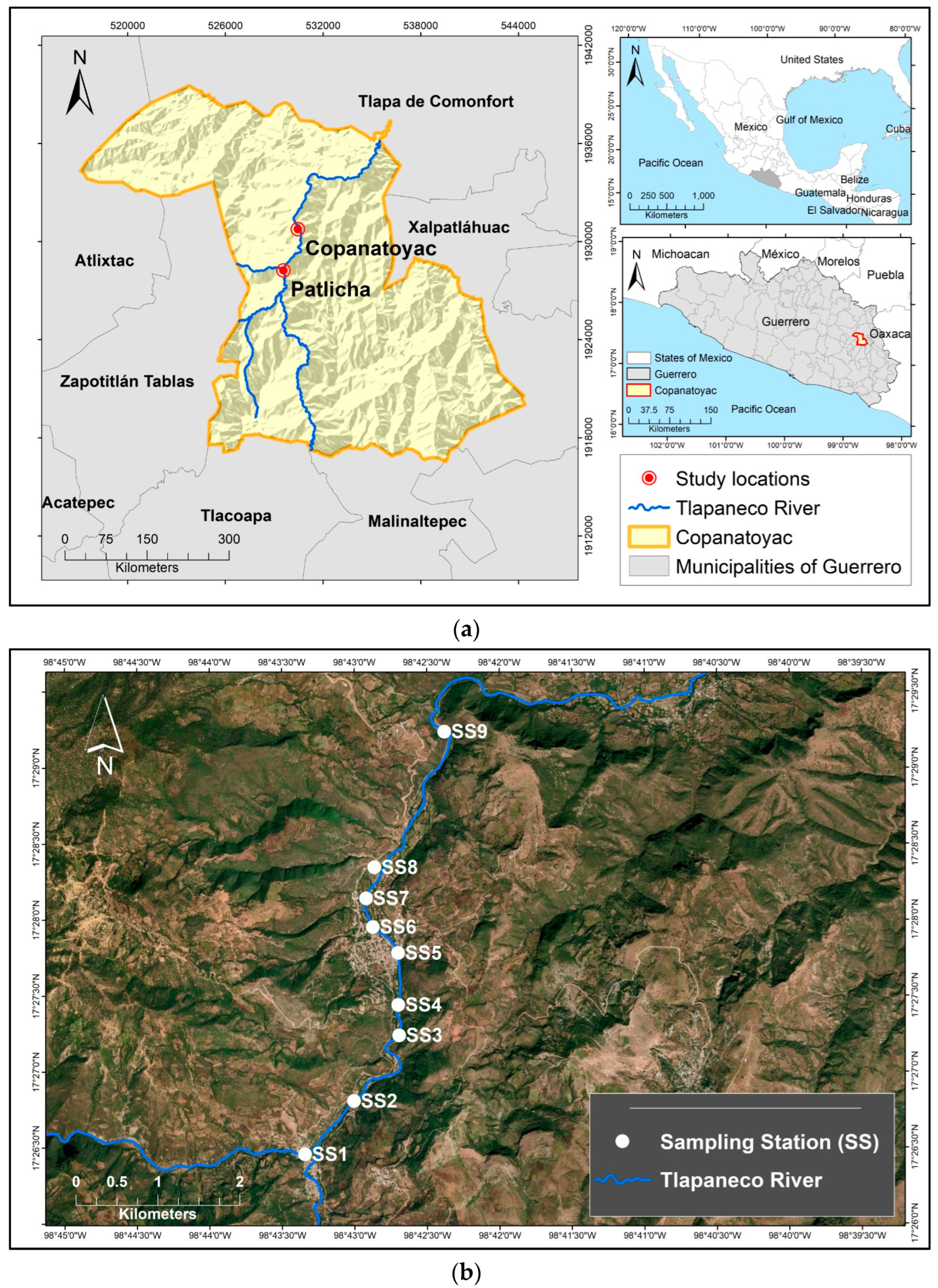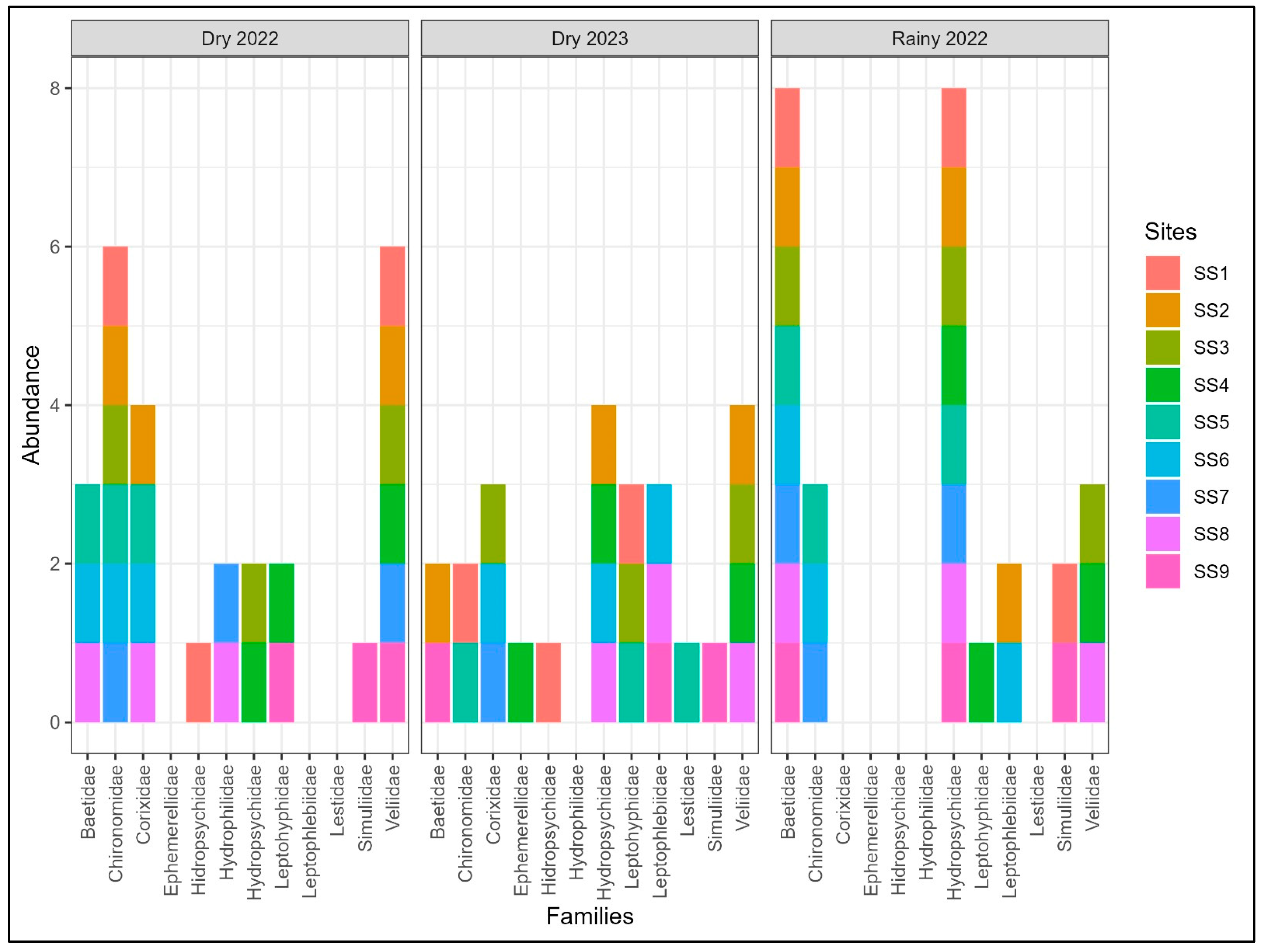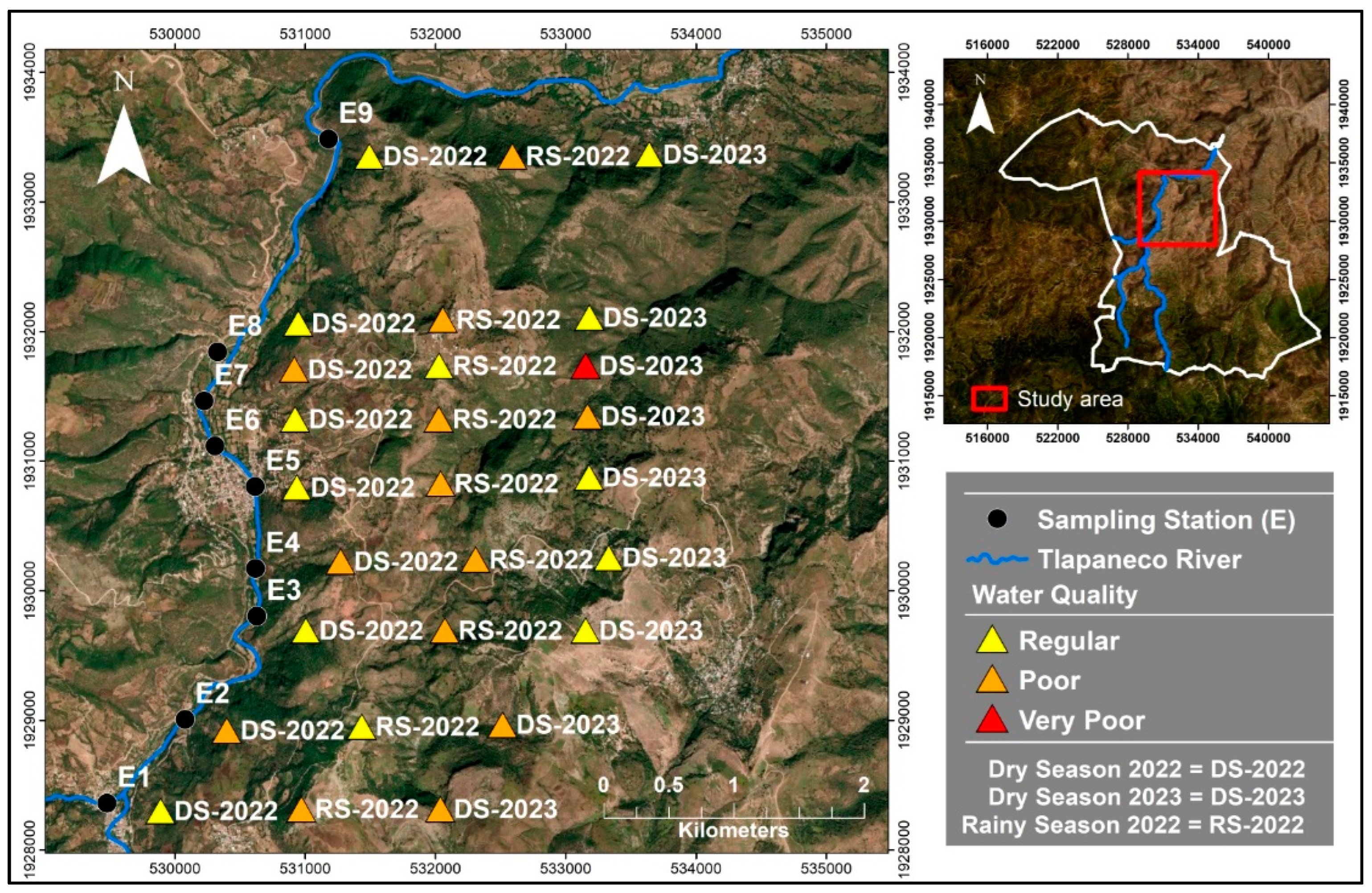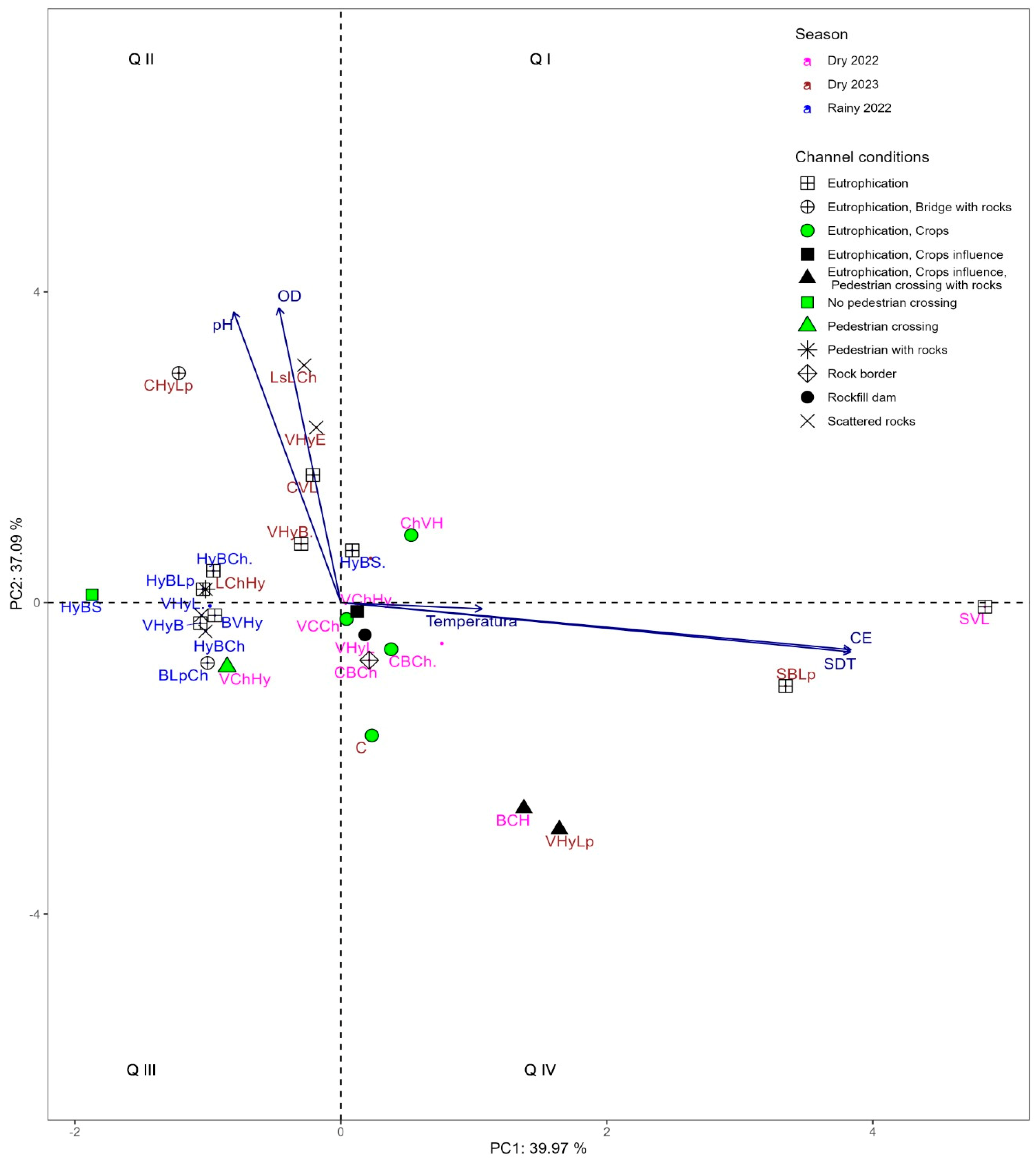Biological Evaluation of Water Quality with the BMWP Index in a Section of the Tlapaneco River Affected by Two Rural Communities in the Guerrero Mountains, Mexico
Abstract
1. Introduction
2. Materials and Methods
2.1. Study Area and Selection of Sampling Sites
2.2. Data Collection
2.2.1. Macroinvertebrate Sampling
2.2.2. Assessment of Water Quality with the BMWP-CR Index
2.2.3. Specific Physicochemical Analysis
2.3. Data Analysis
3. Results
3.1. Macroinvertebrate Biodiversity
3.2. Physicochemical Analysis
Principal Component Analysis of Physicochemical Variables
4. Discussion
4.1. Anthropic Influence and the Relationship of Macroinvertebrates Are Present in the Study Area
4.2. Physicochemical Parameters
5. Conclusions
Author Contributions
Funding
Data Availability Statement
Acknowledgments
Conflicts of Interest
References
- Garcia, X.; Pargament, D. Rehabilitating rivers and enhancing ecosystem services in a water-scarcity context: The Yarqon River. Int. J. Water Resour. Dev. 2015, 31, 73–87. [Google Scholar] [CrossRef]
- Rincón-Bello, M.T.; Soler-Romero, F.Y.; Calderón-Rivera, D.S.; Sierra-Parada, R.J.; Jaramillo-Londoño, A.M. Macroinvertebrados acuáticos como bioindicadores de calidad de agua en el río Chicú, Cundinamarca, Colombia. Hidrobiológica 2021, 31, 17–29. [Google Scholar] [CrossRef]
- Orozco-González, C.E.; Ocasio-Torres, M.E. Aquatic Macroinvertebrates as Bioindicators of Water Quality: A Study of an Ecosystem Regulation Service in a Tropical River. Ecologies 2023, 4, 209–228. [Google Scholar] [CrossRef]
- Odum, E.P. Ecología; Nueva Editorial Interamericana: Mexico City, Mexico, 1972. [Google Scholar]
- Gudiño-Sosa, L.F.; Moncayo-Estrada, R.; Velázquez-Machuca, M.A.; Cruz-Cárdenas, G.; Ávila-Meléndez, L.A.; Pimentel-Equihua, J.L. Biotic Integrity, Water Quality, and Landscape Characteristics of a Subtropical River. Water 2023, 15, 1748. [Google Scholar] [CrossRef]
- Gudiño-Sosa, L.F.; Escalera-Gallardo, C.; Cruz-Cárdenas, G.; Moncayo-Estrada, R.; Silvia-García, J.T.; Flores-Magallón, R.; Damián-Arroyo, M.; Chávez-Tinoco, M.A. Evaluación de la calidad del agua en un río subtropical y tributarios utilizando índices fisicoquímicos y macroinvertebrados acuáticos. Hidrobiológica 2022, 32, 33–50. [Google Scholar] [CrossRef]
- Ruiz-Picos, R.A.; Kohlmann, B.; Sedeño-Díaz, J.E.; López-López, E. Assessing ecological impairments in Neotropical rivers of Mexico: Calibration and validation of the Biomonitoring Working Party Index. Int. J. Environ. Sci. Technol. 2017, 14, 1835–1852. [Google Scholar] [CrossRef]
- UNESCO. Informe Mundial de las Naciones Unidas Sobre el Desarrollo de los Recursos Hídricos 2023. Alianzas y Cooperación por el Agua. Datos, cifras y Ejemplos de Acción. Available online: https://www.pseau.org/outils/ouvrages/un_water_unesco_informe_mundial_de_las_naciones_unidas_sobre_el_desarrollo_de_los_recursos_hidricos_2023_alianzas_y_cooperacion_por_el_agua_datos_cifras_y_ejemplos_de_accion_2023.pdf (accessed on 3 February 2024).
- UNESCO. Informe Mundial de las Naciones Unidas Sobre el Desarrollo de los Recursos Hídricos 2023. Alianzas y Cooperación por el Agua. Available online: https://aneas.com.mx/wp-content/pdf/documentos-internacionales/05-un-wwdr-2023-spanish_web-version.pdf (accessed on 3 February 2024).
- CDP. Treading Water. Corporate Responses to Rising Water Challenges. Available online: https://cdn.cdp.net/cdp-production/cms/reports/documents/000/004/232/original/CDP_Global_Water_Report_2018.pdf?1554392583 (accessed on 5 February 2024).
- Flörke, M.; Schneider, C.; McDonald, R.I. Water competition between cities and agriculture driven by climate change and urban growth. Nat. Sustain. 2018, 1, 51–58. [Google Scholar] [CrossRef]
- Martínez-Austria, P.F. Los retos de la seguridad hídrica. Tecnol. Cienc. Agua 2013, 4, 165–180. [Google Scholar]
- CESOP. En Contexto: Los Ríos Revueltos, Radiografía de la Contaminación. Available online: http://www5.diputados.gob.mx/index.php/camara/Centros-de-Estudio/CESOP/Novedades/En-contexto.-Los-rios-revueltos-radiografia-de-la-contaminacion (accessed on 8 February 2024).
- CONAPO. Informe Anual Sobre la Situación de Pobreza y Rezago Social 2023. Guerrero. Available online: https://www.gob.mx/cms/uploads/attachment/file/793094/12020-Copanatoyac23.pdf (accessed on 10 February 2024).
- Rodríguez, A.L.; López, R.; Bautista, S. Culturas adaptativas en la cuenca del río Tlapaneco, Guerrero, México. Tlamati 2015, 6, 51–54. [Google Scholar]
- Jaramillo-Villanueva, J.L.; Galindo-de-Jesús, G.; Bustamante-González, Á.; Cervantes-Vargas, J. Valoración económica del agua del río Tlapaneco en la “Montaña de Guerrero”, México. Trop. Subtrop. Agroecosystems 2013, 16, 363–376. [Google Scholar] [CrossRef]
- INEGI. Compendio de Información Geográfica Municipal 2010. Available online: https://www.inegi.org.mx/contenidos/app/mexicocifras/datos_geograficos/12/12020.pdf (accessed on 7 February 2024).
- CONAGUA. Normales Climatológicas por Estado. Base de Datos Climatológica Nacional. Available online: https://smn.conagua.gob.mx/es/climatologia/informacion-climatologica/normales-climatologicas-por-estado (accessed on 15 February 2024).
- Mafla, M. Guía para Evaluaciones Ecológicas Rápidas con Indicadores Biológicos en Ríos de Tamaño Mediano Talamanca-Costa Rica; Centro Agronómico Tropical de Investigación y Enseñanza, CATIE: Turrialba, Costa Rica, 2005. [Google Scholar]
- Merritt, R.W.; Cummins, K.W.; Berg, M.B. An Introduction to the Aquatic Insects of North America; Kendall/Hunt: Dubuque, IA, USA, 2008. [Google Scholar]
- Gutiérrez Fonseca, P.E.; Alonso-Rodríguez, A.M. Guía Fotográfica de Familias de Macroinvertebrados Acuáticos de Puerto Rico. Available online: https://www.researchgate.net/publication/295854904_Guia_fotografica_de_familias_de_macroinvertebrados_acuaticos_de_Puerto_Rico (accessed on 23 August 2024).
- Box, G.E.P.; Cox, D.R. An Analysis of Transformations. J. R. Stat. Soc. Ser. B Metholodogical 1964, 26, 211–243. [Google Scholar] [CrossRef]
- Bartlett, M.S. Properties of Sufficiency and Statistical Tests. Proc. R. Soc. London Ser. A Math. Phys. Sci. 1937, 160, 268–282. [Google Scholar]
- Conover, W.J. Practical Nonparametric Statistics; John Wiley & Sons, Inc.: Hoboken, NJ, USA, 1999. [Google Scholar]
- Royston, P. Remark AS R94: A remark on algorithm AS 181: The W-test for normality. J. R. Stat. Society. Ser. C Appl. Stat. 1995, 44, 547–551. [Google Scholar] [CrossRef]
- Mavrou, I. Análisis factorial exploratorio: Cuestiones conceptuales y metodológicas. Nebrija Lingüística Apl. Enseñanza Leng. 2015, 19, 71–80. [Google Scholar] [CrossRef]
- Bustamante-González, A.; Galindo-De Jesús, G.; Jaramillo-Villanueva, J.L.; Vargas-López, S. Percepción de la contaminación del río Tlapaneco por la población ribereña. Agric. Soc. Desarro. 2016, 13, 47–62. [Google Scholar] [CrossRef]
- Vargas-Tierras, T.; Suárez-Cedillo, S.; Morales-León, V.; Vargas-Tierras, Y.; Tinoco-Jaramillo, L.; Viera-Arroyo, W.; Vásquez-Castillo, W. Ecological River Water Quality Based on Macroinvertebrates Present in the Ecuadorian Amazon. Sustainability 2023, 15, 5790. [Google Scholar] [CrossRef]
- Oscoz, J.; Galicia, D.; Miranda, R. Identification Guide of Freshwater Macroinvertebrates of Spain; Springer: Berlin/Heidelberg, Germany, 2011. [Google Scholar]
- Rodríguez, L.; Ríos, P.; Espinosa, M.; Cedeño, P.; Jiménez, G. Caracterización de la calidad de agua mediante macroinvertebrados bentónicos en el río Puyo, en la Amazonía Ecuatoriana. Hidrobiológica 2016, 26, 497–507. [Google Scholar] [CrossRef]
- Thakur, Y.; Grover, A.; Sinha, R. Differential distribution of macroinvertebrate associated with water quality. World Water Policy 2023, 9, 84–112. [Google Scholar] [CrossRef]
- Cabrera, S.; Forio, M.A.E.; Lock, K.; Vandenbroucke, M.; Oña, T.; Gualoto, M.; Goethals, P.L.M.; Van der heyden, C. Variations in Benthic Macroinvertebrate Communities and Biological Quality in the Aguarico and Coca River Basins in the Ecuadorian Amazon. Water 2021, 13, 1692. [Google Scholar] [CrossRef]
- Enger, E.D.; Smith, B.F. Ciencia Ambiental. Un Estudio de Interrelaciones; The McGraw-Hill Companies, Inc.: Chicago, IL, USA, 2006. [Google Scholar]
- Echeverría-Sáenz, S.; Ugalde-Salazar, R.; Guevara-Mora, M.; Quesada-Alvarado, F.; Ruepert, C. Ecological Integrity Impairment and Habitat Fragmentation for Neotropical Macroinvertebrate Communities in an Agricultural Stream. Toxics 2022, 10, 346. [Google Scholar] [CrossRef]
- Cabrera, M.; Capparelli, M.V.; Nacato-Ch, C.; Moulatlet, G.M.; Lopez-Heras, I.; Diaz, M.; Alvear-S, D.; Rico, A. Effects of intensive agriculture and urbanization on water quality and pesticide risks in freshwater ecosystems of the Ecuadorian Amazon. Chemosphere 2023, 337, 139286. [Google Scholar] [CrossRef]
- Cabrera-Garcia, S.; Goethals, P.L.M.; Lock, K.; Domínguez-Granda, L.; Villacís, M.; Galárraga-Sánchez, R.; Van der Heyden, C.; Forio, M.A.E. Taxonomic and Feeding Trait-Based Analysis of Macroinvertebrates in the Antisana River Basin (Ecuadorian Andean Region). Biology 2023, 12, 1386. [Google Scholar] [CrossRef] [PubMed]
- Coayla-Peñaloza, P.; Cheneaux-Díaz, A.A.; Moreno-Salazar, C.V.; Cruz-Remache, C.E.; Colque-Rondón, E.W.; Damborenea, C. Benthic macroinvertebrate communities and water quality assessment in high Andean wetlands Callali-Oscollo, Arequipa-Cusco, Peru. Rev. Mex. Biodivers. 2023, 94, e944206. [Google Scholar] [CrossRef]
- Quesada-Alvarado, F.; Umaña, G.; Springer, M.; Picado, J. Variación estacional y características fisicoquímicas e hidrológicas que influyen en los macroinvertebrados acuáticos, en un río tropical. Biol. Trop. 2020, 68, 54–67. [Google Scholar] [CrossRef]
- Flowers, R.W.; De la Rosa, C. Capítulo 4. Ephemeroptera. Rev. Biol. Trop. 2010, 58, 63–93. [Google Scholar]
- Damanik-Ambarita, M.N.; Lock, K.; Boets, P.; Everaert, G.; Nguyen, T.H.T.; Forio, M.A.E.; Musonge, P.L.S.; Suhareva, N.; Bennetsen, E.; Landuyt, D.; et al. Ecological water quality analysis of the Guayas river basin (Ecuador) based on macroinvertebrates indices. Limnologica 2016, 57, 27–59. [Google Scholar] [CrossRef]
- Lafuente, W.; Carpio, A.J.; Alcácer, C.; Moreno, J.L. Spatio-temporal variability of physicochemical conditions in the headwaters of neotropical streams. J. South Am. Earth Sci. 2023, 126, 104361. [Google Scholar] [CrossRef]
- Jaime, S.; Cervantes-Martínez, A.; Gutiérrez-Aguirre, M.A.; Hernández-Flores, G.; González-Herrera, R.A.; Sánchez-Rivera, G.; Enseñat-Soberanis, F.; Delgado-Blas, V.H. Toward an Integrative Overview of Stygobiotic Crustaceans for Aquifer Delimitation in the Yucatan Peninsula, Mexico. Diversity 2025, 17, 77. [Google Scholar] [CrossRef]
- Mihelcic, J.R.; Zimmerman, J.B. Ingeniería Ambiental: Fundamentos, Sustentabilidad, Diseño; Editorial Alfaomega: Mexico City, Mexico, 2012. [Google Scholar]
- Molinero, J.; Barrado, M.; Guijarro, M.; Ortiz, M.; Carnicer, O.; Zuazagoitia, D. The Teaone River: A snapshot of a tropical river from the coastal region of Ecuador. Limnetica 2019, 38, 587–605. [Google Scholar] [CrossRef]
- Contreras, J.; Roldán, G.; Arango, A.; Álvarez, L.F. Evaluación de la calidad del agua de las microcuencas La Laucha, La Lejía y La Rastrojera utilizando los macroinvertebrados como bioindicadores, Municipio de Durania, Departamento Norte de Santander, Colombia. Rev. Acad. Colomb. Cienc. Exactas Físicas Nat. 2008, 32, 171–194. [Google Scholar] [CrossRef]
- Contieri, B.B.; Rosa, J.; Scoarize, M.M.R.; Urbano, V.A.; Benedito, E. Anthropogenic land uses lead to changes in limnological variables in Neotropical streams. Environ. Monit. Assess. 2024, 196, 702. [Google Scholar] [CrossRef] [PubMed]






| Sampling Sites | Permanent Anthropic Activity | Dry Season 2022 | Rainy Season 2022 | Dry Season 2023 |
|---|---|---|---|---|
| SS1 | Sewage discharge, farm, domestic use, leaving the urban Patlicha area, crops area | Pedestrian crossing | No pedestrian crossing | Pedestrian with rocks |
| SS2 | Sewage discharge, crops area | Eutrophication, partial crops in the riverbed | Eutrophication | Eutrophication |
| SS3 | Sewage discharge, crops area | Eutrophication, crops influence | Eutrophication | Eutrophication |
| SS4 | Sewage discharge, recreational, entrance to the Copanatoyac urban area, crops area | Rockfill dam | Scattered rocks | Scattered rocks |
| SS5 | Sewage discharge, domestic use, center of the Copanatoyac urban area, crops area | Rock border | Scattered rocks, anthropogenic silting | Scattered rocks, concrete remains |
| SS6 | Sewage discharge, recreational, leaving the urban Copanatoyac area, crops area | Eutrophication Riparian zone cultivation | Eutrophication, bridge with rocks and concrete remains | Eutrophication, bridge with rocks and concrete remains |
| SS7 | Sewage discharge, crops area | Eutrophication, partial crops in the riverbed | Eutrophication | Eutrophication, total cultivation in the riverbed |
| SS8 | Sewage discharge, livestock watering place, crops area | Eutrophication, crops influence, pedestrian crossing with rocks | Eutrophication | Eutrophication, crops influence, pedestrian crossing with rocks |
| SS9 | Sewage discharge, sand and gravel extraction, crops area | Eutrophication | Eutrophication | Eutrophication |
| Source | Df | Sum Sq | Mean Sq | F Value | p-Value |
|---|---|---|---|---|---|
| Season | 2 | 425.852 | 212.926 | 1.192 | 0.326 |
| Zone | 2 | 11.630 | 5.815 | 0.033 | 0.968 |
| Season: Zone | 4 | 240.815 | 60.204 | 0.337 | 0.849 |
| Residuals | 18 | 3215.333 | 178.630 |
| Variable | n | Test Statistic | Dry 2022 | Dry 2023 | Rainy 2022 |
|---|---|---|---|---|---|
| Temperature | 9 | T = 3.532 | 25.86 ± 2.81 (a) | 22.91 ± 2.52 (b) | 18.4 ± 2.32 (c) |
| pH | 9 | KW = 1.226 | 8.37 ± 0.29 (a) | 8.62 ± 0.64 (a) | 8.42 ± 0.18 (a) |
| EC | 9 | KW = 12.710 | 382 ± 145.99 (a) | 332.89 ± 127.02 (a) | 223.78 ± 44.38 (b) |
| TDS | 9 | KW = 12.641 | 191 ± 73.2 (a) | 166.44 ± 63.42 (a) | 112.11 ± 22.27 (b) |
| DO | 9 | KW = 4.492 | 6.47 ± 1.7 (b) | 8.51 ± 3.17 (a) | 7.69 ± 0.42 (ab) |
| Variables | Season | SS1 | SS2 | SS3 | SS4 | SS5 | SS6 | SS7 | SS8 | SS9 | Mean | SD |
|---|---|---|---|---|---|---|---|---|---|---|---|---|
| T °C | Dry 2022 | 27.80 | 26.80 | 24.30 | 28.60 | 27.10 | 20.00 | 24.10 | 25.10 | 28.90 | 25.86 | 2.81 |
| Rainy 2022 | 17.70 | 19.30 | 20.30 | 20.80 | 19.10 | 18.80 | 17.20 | 19.40 | 13.00 | 18.40 | 2.32 | |
| Dry 2023 | 18.70 | 20.00 | 21.30 | 23.30 | 24.70 | 26.50 | 25.20 | 23.50 | 23.00 | 22.91 | 2.52 | |
| pH | Dry 2022 | 8.33 | 8.35 | 8.43 | 8.63 | 8.52 | 8.37 | 8.59 | 7.66 | 8.44 | 8.37 | 0.29 |
| Rainy 2022 | 8.50 | 8.50 | 8.30 | 8.40 | 8.30 | 8.10 | 8.60 | 8.40 | 8.70 | 8.42 | 0.18 | |
| Dry 2023 | 8.54 | 8.52 | 8.80 | 9.14 | 9.37 | 9.47 | 8.11 | 7.56 | 8.04 | 8.62 | 0.64 | |
| E.C (µs/cm) | Dry 2022 | 238 | 316 | 324 | 334 | 337 | 348 | 359 | 435 | 747 | 382.00 | 145.99 |
| Rainy 2022 | 144 | 219 | 217 | 219 | 221 | 221 | 224 | 229 | 320 | 223.78 | 44.38 | |
| Dry 2023 | 222 | 283 | 292 | 298 | 290 | 207 | 336 | 454 | 614 | 332.89 | 127.02 | |
| TDS (mg/L) | Dry 2022 | 119 | 158 | 162 | 167 | 168 | 174 | 179 | 218 | 374 | 191.00 | 73.20 |
| Rainy 2022 | 73 | 110 | 108 | 109 | 110 | 110 | 115 | 113 | 161 | 112.11 | 22.27 | |
| Dry 2023 | 111 | 142 | 146 | 148 | 144 | 103 | 168 | 232 | 304 | 166.44 | 63.42 | |
| DO (mg/L) | Dry 2022 | 5.77 | 7.50 | 7.40 | 5.48 | 5.07 | 6.28 | 9.52 | 3.75 | 7.50 | 6.47 | 1.70 |
| Rainy 2022 | 7.73 | 7.93 | 7.63 | 7.43 | 7.32 | 7.12 | 8.14 | 7.43 | 8.44 | 7.69 | 0.42 | |
| Dry 2023 | 7.73 | 9.56 | 10.78 | 10.88 | 12.10 | 11.29 | 4.27 | 3.46 | 6.51 | 8.51 | 3.17 |
| Principal Components | PC1 | PC2 | PC3 | PC4 | PC5 |
|---|---|---|---|---|---|
| Eigenvalue | 2.00 | 1.85 | 1.04 | 0.11 | 0.00 |
| % variation | 39.97 | 37.09 | 20.76 | 2.18 | 0.00 |
| Cum. % variation | 39.97 | 77.06 | 97.82 | 100.00 | 100.00 |
| Variables | Eigenvalues | ||||
| Temperature | 0.53 | 0.49 | −0.69 | 0.08 | 0.00 |
| pH | −0.66 | 0.72 | −0.05 | −0.22 | −0.00 |
| EC | 0.88 | 0.38 | 0.28 | −0.02 | −0.01 |
| TDS | 0.88 | 0.37 | 0.28 | −0.02 | 0.01 |
| DO | −0.68 | 0.65 | 0.26 | 0.21 | 0.00 |
Disclaimer/Publisher’s Note: The statements, opinions and data contained in all publications are solely those of the individual author(s) and contributor(s) and not of MDPI and/or the editor(s). MDPI and/or the editor(s) disclaim responsibility for any injury to people or property resulting from any ideas, methods, instructions or products referred to in the content. |
© 2025 by the authors. Licensee MDPI, Basel, Switzerland. This article is an open access article distributed under the terms and conditions of the Creative Commons Attribution (CC BY) license (https://creativecommons.org/licenses/by/4.0/).
Share and Cite
Pantiga-Tapia, A.; Rosas-Acevedo, J.L.; Guzmán-Martínez, M.; Solís-Navarrete, J.A.; Bedolla-Solano, R.; Anzaldúa-Soulé, K.R. Biological Evaluation of Water Quality with the BMWP Index in a Section of the Tlapaneco River Affected by Two Rural Communities in the Guerrero Mountains, Mexico. Environments 2025, 12, 91. https://doi.org/10.3390/environments12030091
Pantiga-Tapia A, Rosas-Acevedo JL, Guzmán-Martínez M, Solís-Navarrete JA, Bedolla-Solano R, Anzaldúa-Soulé KR. Biological Evaluation of Water Quality with the BMWP Index in a Section of the Tlapaneco River Affected by Two Rural Communities in the Guerrero Mountains, Mexico. Environments. 2025; 12(3):91. https://doi.org/10.3390/environments12030091
Chicago/Turabian StylePantiga-Tapia, Aide, José Luis Rosas-Acevedo, María Guzmán-Martínez, José Alberto Solís-Navarrete, Ramón Bedolla-Solano, and Karla Rosalba Anzaldúa-Soulé. 2025. "Biological Evaluation of Water Quality with the BMWP Index in a Section of the Tlapaneco River Affected by Two Rural Communities in the Guerrero Mountains, Mexico" Environments 12, no. 3: 91. https://doi.org/10.3390/environments12030091
APA StylePantiga-Tapia, A., Rosas-Acevedo, J. L., Guzmán-Martínez, M., Solís-Navarrete, J. A., Bedolla-Solano, R., & Anzaldúa-Soulé, K. R. (2025). Biological Evaluation of Water Quality with the BMWP Index in a Section of the Tlapaneco River Affected by Two Rural Communities in the Guerrero Mountains, Mexico. Environments, 12(3), 91. https://doi.org/10.3390/environments12030091








